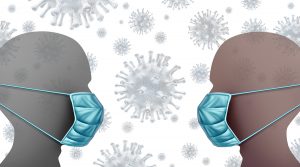New studies showed that physical distancing is effective for Covid-19 coronavirus prevention. Specifically, a study from the Lancet medical journal dated June 1, 2020 analyzed 172 observational studies around the globe. This involved 25,697 patients. The researchers found the following data.
Findings regarding distancing
Chance of transmission at 1 meter (3.3 feet): 12.8%
Chance of transmission at 2 meters (6.6 feet): 2.6%
The evidence on distancing was “moderate”.
Face masks
Chance of transmission without a face mask: 17.4%
Chance of transmission when face mask is worn: 3.1%
This translates into a reduction of 82.2% when 17.4% (transmission without face mask) is set at a baseline of 100%.
The evidence regarding face masks was “low”.
Eye protection
Chance of transmission without eye protection: 16%
Chance of transmission with eye protection: 5.5%
This eye protection could be wearing of glasses, face shield, visor or goggles. The evidence for eye protection was “low”.
Handwashing also important
Although not formally measured in this report, hand washing is also important to stop transmission of the virus.
Another study looking at the effects of social distancing
In addition, there was a publication from the Canadian Medical Association Journal regarding the transmission of the Covid-19 coronavirus. These researchers conducted a prospective study including 375,609 cases in 144 geopolitical areas worldwide. They looked at an association between Covid-19 coronavirus cases and various measures to control its growth.
Here are the results:
Restriction of mass gatherings: 35% reduction of infection rate
School closures: 37% reduction of infection rate
Social distancing (2 meters of 6.6 ft): 38% reduction of infection rate
Conclusion
There is presently no cure for Covid-19 coronavirus. But there are ways to interrupt transmission of the virus from infected persons to non-infected persons. These methods are generally known as social distancing. One study found that a distance of 2 meters (6.6 feet) reduces transmission to 2.6% from 12.8% at 1 meter (3.3 feet). Another study found that the infection rate was reduced to 38% at 2 meters (6.6 feet) distance. Wearing of a face mask reduces the risk of transmission from 17.4% (no face mask) to 3.1%. Eye protection reduces the risk of transmission from 16% (no eye protection) to 5.5%. Restriction of mass gatherings reduce the infection rate by 35%, school closures by 37%.
Synergistic effect when several restrictive measures in place
When all these measures are taken together, there is a synergistic effect that protects us even more from the transmission of the virus than the sum of each effect. This is the reason why some countries control the infection rate from Covid-19 really well, but others that were laxer in their restrictions suffer higher infection rates.
As long as there is no effective treatment or vaccination available, it is important to use all the available prevention methods to stop the spread of the virus. Effective vaccinations will likely only be available in April or May 2021.







